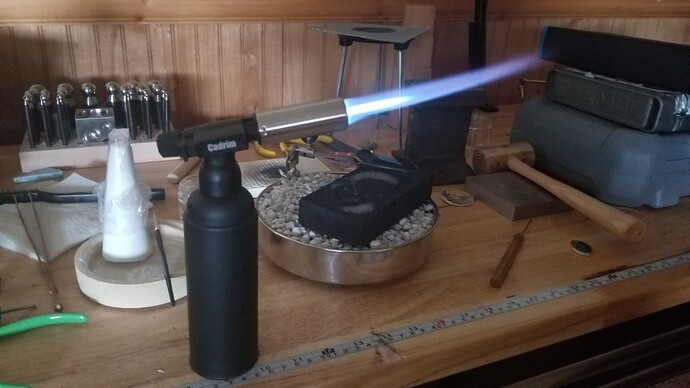Hello Everyone!
I’m new to the community and am totally jazzed/thrilled to see such a vibrant area on the web where newbies like myself may hopefully learn from Veteran silversmiths.
A little bit of background: This past spring I essentially spent 2 months “in school” by purchasing every book I could on silversmithing. I studied, studied, studies 7-8 hours a day obsessively. I’m very determined to learn this art medium and want to eventually begin a small business with it.
Now onto the embarrassing newbie questions: Even with all that research and being well versed in much of the terminology and concepts - I’ve just sat down to trying out some simple projects and am coming to a stand still block.
I have put together a nice little beginner’s work station - I basically bought it all. I have a jeweler’s saw, blades, Dremel with plenty of attachments to match (radial discs, buffers, sanders, drills, burrs, etc), flexi sanders, needle files, metal cutting shears, all pliers, chasing/riveting hammers, and on and on… I have bought a good introductory amount of sheet metals and various wire gauges. I essentially set myself up with everything I knew I was eventually going to need.
I am a very “organic” person (don’t judge me! haha!), and so I was hoping to keep things as natural as possible with my pickle/flux solutions. First I tried vinegar/salt - that didn’t work at all. Now I’m onto a pure citric acid mixture. The real problem is soldering. I simply can’t seem to get my solder to melt let alone flow properly. Yes, I’ve watched various tutorials on this process too and it isn’t helping. I have purchased easy, medium, and hard solder. I somewhat understand the concept of when to use each, such as sort of working your way down (from hard to easy) depending on how many soldering joins you may need to do in a piece. Do I have that right?
I’ve chosen a borax cone for my flux and have a simple kitchen butane torch for heating. I’ve no clue if I’ve made a mistake or not with these two choices. When I try to do a simple solder join for a simple copper bezel (making the initial circle not soldering it to the plate yet), I used some homemade borax-distilled water slurry to paint the joins and surrounding areas - carefully sanded the joins so that they perfectly touch flush with one another - set a small piece of hard solder at the join - and went for it… It seems to take FOREVER to get the solder to melt with my torch, and when it finally did, it didn’t climb up the join. Instead it just created a tiny “dot” blob on the side and never climbed.
What am I doing wrong? Is my tiny butane torch not powerful enough? Do I need a different type of gas? And is a simple borax cone also not very powerful flux? When reading other forums, it seems like professional silversmiths have had no problem with just simple borax as a flux.
I’m so confused as to why I can’t get any solder to melt or join… 


Any help in actually succeeding at this would be greatly appreciated.


